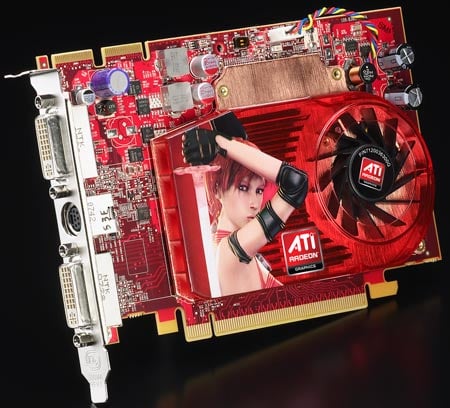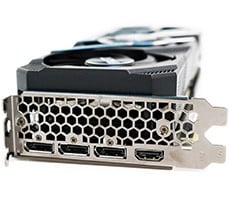
When AMD launched the RV670 GPU at the heart of the ATI Radeon HD 3870 and 3850 series of products, they received quite a bit of fanfare due to the product's competitive prices, strong performance, and more manageable power profiles. One of the main reasons AMD was able to bring the Radeon HD 3870 and 3850 to market with these attributes was because the company had migrated their GPUs to a relatively more advanced 55nm process technology. Manufacturing the GPUs at 55nm meant they were more economical to produce, required less power than the previous generation, and could run at higher clock speeds.
AMD didn’t stop there, however. They have since taken the very same design principles that brought forth the RV670 and used them for a couple of new mainstream and entry-level GPUs. Today AMD is officially unveiling the Radeon HD 3650 and the Radeon HD 3450 / 3470, which are based on the 55nm RV635 and RV620 GPUs, respectively. Like the RV670 that came before them, the RV635 and RV620 are competitively priced DirectX 10.1 compliant GPUs that offer full UVD support.
We’ve got the top of the line Radeon HD 3650 in house and have put it through the wringer with some of today’s hottest games and video tests. Read on to see just how AMD’s new sub-$100 mainstream graphics card performed in our battery of tests...

ATI Radeon HD 3650
|

|
|
ATI Radeon HD 3650 |
|
Features & Specifications | |
|
- 378 million transistors on 55nm fabrication process
- PCI Express 2.0 x16 bus interface
- 128-bit DDR2/GDDR3 memory interface
- Microsoft DirectX 10.1 support
- Shader Model 4.1
- 32-bit floating point texture filtering
- Indexed cube map arrays
- Independent blend modes per render target
- Pixel coverage sample masking
- Read/write multi-sample surfaces with shaders
- Gather4 texture fetching
- Unified Superscalar Shader Architecture
- 120 stream processing units
- Dynamic load balancing and resource allocation for vertex, geometry, and pixel shaders
- Common instruction set and texture unit access supported for all types of shader
- Dedicated branch execution units and texture address processors
- 128-bit floating point precision for all operations
- Command processor for reduced CPU overhead
- Shader instruction and constant cache
- Up to 40 texture fetches per clock cycle
- Up to 128 textures per pixel
- Fully associative multi-level texture cache design
- DXTC and 3Dc+ texture compression
- High resolution texture support (up to 8192 x 8192)
- Fully associative texture Z/stencil cache designs
- Double-sided hierarchical Z/stencil buffer
- Early Z test, Re-Z, Z Range optimization, and Fast Z Clear
- Lossless Z & stencil compression
- Lossless color compression
- 8 render targets (MRTs) with anti-aliasing support
- Physics processing support
- Dynamic Geometry Acceleration
- Programmable tessellation unit
- Accelerated geometry shader path for geometry amplification
- Memory read/write cache for improved stream output performance
- Anti-aliasing features
- Multi-sample anti-aliasing (2, 4 or 8 samples per pixel)
- Up to 24x Custom Filter Anti-Aliasing (CFAA) for improved quality
- Adaptive super-sampling and multi-sampling
- Temporal anti-aliasing
- Gamma correct
- Super AA (ATI CrossFireX configurations only)
- All anti-aliasing features compatible with HDR rendering
- Texture filtering features
- 2x/4x/8x/16x high quality adaptive anisotropic filtering modes (up to 128 taps per pixel)
- 128-bit floating point HDR texture filtering
- Bicubic filtering
- sRGB filtering (gamma/degamma)
- Percentage Closer Filtering (PCF)
- Depth & stencil texture (DST) format support
- Shared exponent HDR (RGBE 9:9:9:5) texture format support
- OpenGL 2.0 support
|
- ATI Avivo HD Video and Display Platform
- Dedicated unified video decoder (UVD) for H.264/AVC and VC-1 video formats
- High definition (HD) playback of both Blu-ray and HD DVD formats
- Hardware MPEG-1, MPEG-2, and DivX video decode acceleration
-
- Motion compensation and IDCT
- ATI Avivo Video Post Processor
- Color space conversion
- Chroma subsampling format conversion
- Horizontal and vertical scaling
- Gamma correction
- Advanced vector adaptive per-pixel de-interlacing
- De-blocking and noise reduction filtering
- Detail enhancement
- Inverse telecine (2:2 and 3:2 pull-down correction)
- Bad edit correction
- Two independent display controllers
- Drive two displays simultaneously with independent resolutions, refresh rates, color controls and video overlays for each display
- Full 30-bit display processing
- Programmable piecewise linear gamma correction, color correction, and color space conversion
- Spatial/temporal dithering provides 30-bit color quality on 24-bit and 18-bit displays
- High quality pre- and post-scaling engines, with underscan support for all display outputs
- Content-adaptive de-flicker filtering for interlaced displays
- Fast, glitch-free mode switching
- Hardware cursor
- Two integrated DVI display outputs
- Primary supports 18-, 24-, and 30-bit digital displays at all resolutions up to 1920x1200 (single-link DVI) or 2560x1600 (dual-link DVI)
- Secondary supports 18-, 24-, and 30-bit digital displays at all resolutions up to 1920x1200 (single-link DVI only)
- Each includes a dual-link HDCP encoder with on-chip key storage for high resolution playback of protected content
- Two integrated DisplayPort outputs
- Supports 24- and 30-bit displays at all resolutions up to 2560x1600
- 1, 2, or 4 lanes per output, with data rate up to 2.7 Gbps per lane
- Two integrated 400 MHz 30-bit RAMDACs
- Each supports analog displays connected by VGA at all resolutions up to 2048x153623
- HDMI output support
- Supports all display resolutions up to 1920x1080
- Integrated HD audio controller with up to 2 channel 48 kHz stereo or multi-channel (5.1) AC3 enabling a plug-and-play cable-less audio solution
- Integrated AMD Xilleon HDTV encoder
- Provides high quality analog TV output (component/S-video/composite)
- Supports SDTV and HDTV resolutions
- Underscan and overscan compensation
- MPEG-2, MPEG-4, DivX, WMV9, VC-1, and H.264/AVC encoding and transcoding
- Seamless integration of pixel shaders with video in real time
- VGA mode support on all display outputs
- ATI PowerPlay
- Advanced power management technology for optimal performance and power savings
- Performance-on-Demand
- Constantly monitors GPU activity, dynamically adjusting clocks and voltage based on user scenario
- Clock and memory speed throttling
- Voltage switching
- Dynamic clock gating
- Central thermal management – on-chip sensor monitors GPU temperature and triggers thermal actions as required
- ATI CrossFireX Multi-GPU Technology
- Scale up rendering performance and image quality with two GPUs
- Integrated compositing engine
- High performance dual channel bridge interconnect
We have previously posted a wealth of information related to today's launch that we recommend you read to get familiar with AMD's new ATI RV635 and RV620 GPUs, their previous GPU architectures, and their key features. The Radeon HD 3650 and 3450 / 3470 are based on a GPU derived from of the R600, and as such they have a number of key features in common that we've already covered in much greater detail that we will here today. The articles we suggest you peruse include:
If you haven't already done so, we recommend scanning through our 3800 and 2x00 series coverage, our Radeon HD 2900 XT launch article, and the Radeon X1950 Pro with Native CrossFire article. In those four pieces, we cover a large number of the features offered by the new Radeon HD 3600 and 3400 series of cards and explain many of the features of DirectX 10. We recommended reading these articles because there is quite a bit of background information in them that'll make it easier to fully understand what we're going to showcase here today. |







